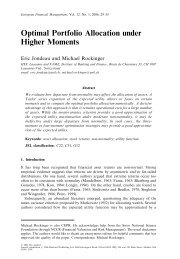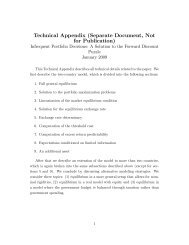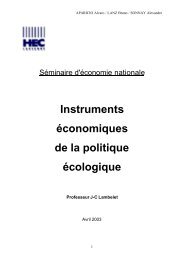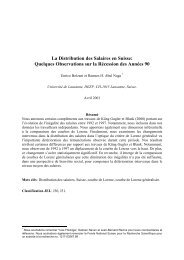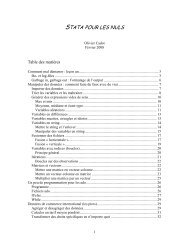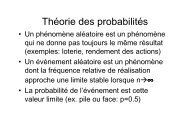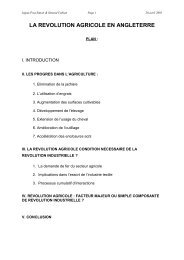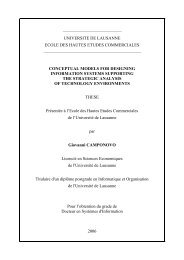The Business Model Ontology - a proposition in a design ... - HEC
The Business Model Ontology - a proposition in a design ... - HEC
The Business Model Ontology - a proposition in a design ... - HEC
You also want an ePaper? Increase the reach of your titles
YUMPU automatically turns print PDFs into web optimized ePapers that Google loves.
<strong>The</strong> <strong>Bus<strong>in</strong>ess</strong> <strong>Model</strong> <strong>Ontology</strong> - a <strong>proposition</strong> <strong>in</strong> a <strong>design</strong> science approach<br />
market model. <strong>The</strong>se sub-models and their <strong>in</strong>terrelation shall describe the logic of a bus<strong>in</strong>ess system<br />
for creat<strong>in</strong>g value that lies beh<strong>in</strong>d the actual processes. <strong>The</strong> value model describes the logic of what<br />
core products, services and experiences are delivered to the customer and other value-added services<br />
derived from the core competence. <strong>The</strong> revenue model describes the logic of how elements are<br />
necessary for the transformation process, and how to identify and procure the required quantities. <strong>The</strong><br />
production model describes the logic of how elements are comb<strong>in</strong>ed <strong>in</strong> the transformation process<br />
from the source to the output. <strong>The</strong> customer relations model scribes the logic of how to reach, serve,<br />
and ma<strong>in</strong>ta<strong>in</strong> customers. It consists of the follow<strong>in</strong>g sub-models: a distribution model – the logic<br />
beh<strong>in</strong>d the delivery processes, a market<strong>in</strong>g model – the logic beh<strong>in</strong>d reach<strong>in</strong>g and ma<strong>in</strong>ta<strong>in</strong><strong>in</strong>g<br />
customers and a service model – the logic beh<strong>in</strong>d serv<strong>in</strong>g the customer. <strong>The</strong> revenue model describes<br />
the logic of what, when, why, and how the company receives compensation <strong>in</strong> return for the products.<br />
<strong>The</strong> capital model describes the logic of how f<strong>in</strong>ancial sourc<strong>in</strong>g occurs to create a debt and equity<br />
structure, and how that money is utilised with respect to assets and liabilities over time. <strong>The</strong> market<br />
model describes the logic of choos<strong>in</strong>g a relevant environment <strong>in</strong> which the bus<strong>in</strong>ess operates.<br />
Compared to the previous authors Magretta (2002) has a very simple and pragmatic view on bus<strong>in</strong>ess<br />
models. She dist<strong>in</strong>guishes between two elementary parts of a bus<strong>in</strong>ess model. On the one hand the<br />
bus<strong>in</strong>ess activities associated with mak<strong>in</strong>g someth<strong>in</strong>g (e.g. <strong>design</strong>, procurement, and manufactur<strong>in</strong>g)<br />
and on the other hand the bus<strong>in</strong>ess activities associated with sell<strong>in</strong>g someth<strong>in</strong>g (e.g. customer<br />
identification, sell<strong>in</strong>g, transaction handl<strong>in</strong>g, distribution and delivery).<br />
3.1.4 Representation Tools<br />
In addition to outl<strong>in</strong><strong>in</strong>g the components of a bus<strong>in</strong>ess model, some authors offer a set of bus<strong>in</strong>ess<br />
model representation tools. Weill and Vitale (2001) have developed a formalism to assist analyz<strong>in</strong>g e-<br />
bus<strong>in</strong>ess <strong>in</strong>itiatives, which they call e-bus<strong>in</strong>ess model schematic. <strong>The</strong> schematic is a pictorial<br />
representation, aim<strong>in</strong>g to high-light a bus<strong>in</strong>ess model's important elements. This <strong>in</strong>cludes the firm of<br />
<strong>in</strong>terest, its suppliers and allies, the major flows of product, <strong>in</strong>formation and money and f<strong>in</strong>ally the<br />
revenues and other benefits each participant receives. By us<strong>in</strong>g such a representation the authors<br />
<strong>in</strong>tend to uncover major contradictions of a bus<strong>in</strong>ess model, highlight the core competencies to<br />
implement the model, show the position of each player <strong>in</strong> the <strong>in</strong>dustry value cha<strong>in</strong>, deduce the<br />
organizational form and IT <strong>in</strong>frastructure for implementation and reveal which entity owns the<br />
customer relationship, data, and transaction.<br />
Service<br />
Provider<br />
Customer<br />
Firm of Interest<br />
Supplier<br />
Customer<br />
Ally<br />
$<br />
0<br />
i<br />
Electronic Relationship<br />
Primary Relationship<br />
Flow of Money<br />
Flow of Product<br />
Flow of Information<br />
Figure 18: bus<strong>in</strong>ess model schematic of the direct to customer model and (Weill and Vitale 2001)<br />
<strong>The</strong> <strong>design</strong> approach of Gordijn (2002), which among other th<strong>in</strong>gs aims at visualiz<strong>in</strong>g bus<strong>in</strong>ess models<br />
is outl<strong>in</strong>ed <strong>in</strong> the follow<strong>in</strong>g section.<br />
3.1.5 Ontological <strong>Model</strong>l<strong>in</strong>g<br />
Whereas the bus<strong>in</strong>ess model frameworks presented until here stay relatively <strong>in</strong>formal and descriptive<br />
this section treats of ontology-style models. Under ontological modell<strong>in</strong>g I understand a rigorous<br />
approach to def<strong>in</strong><strong>in</strong>g bus<strong>in</strong>ess models. In other terms this means carefully and precisely def<strong>in</strong><strong>in</strong>g<br />
bus<strong>in</strong>ess model terms, concepts, components and their relationships. From the authors analyzed <strong>in</strong> this<br />
literature review Gordijn (2002) provides the most rigorous conceptual model<strong>in</strong>g approach, which he<br />
35




